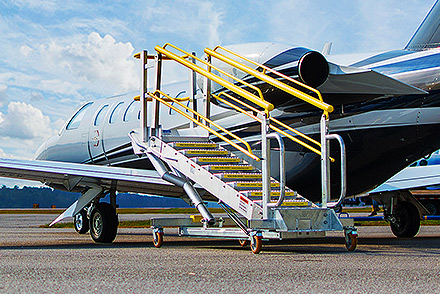If you’ve been working in any industrial facility for any length of time, chances are that you’ve had to move around heavy items like pallets or boxes. Heavy lifting and constant mobility can be dangerous and difficult for workers, so you want to make sure you get the right equipment.
One of the indispensable tools for the jobs described above is a rolling ladder. Where forklifts might be impractical, these mobile stairs make it much easier to move around these large objects at varying heights without straining your body or risking injury. However, there are many different types of rolling ladders on the market today with a wide range of prices and features, so it can be hard to know which one is best for your needs!
The first thing you need to think about is: how much weight the ladder will have to support, and at what heights will these ladders be required? Verify your answers to these two questions first, as they are vital to consider when choosing a mobile ladder stand. The second factor is the size of the rolling ladder platform. It would be best to consider how much of a footprint/setup area you have and your budget for this purchase.

A ladder footprint is a space where a ladder is standing while being used for construction, art projects, or other purposes. The desired location of a ladder is juxtaposed using a template to calculate the distance between rungs and adjusting as needed to create an accurate ground layout.
Lastly, go over our guide to working safely with ladder stands and platforms to brush up on the design, training, inspection, and usage of these mobile ladder platforms!
Taking into Account Working Load and Size
Mobile ladder manufacturers usually stick informational labels on their products. These labels often remind users about the ladder’s “duty rating.” These ratings take into account the ladder’s type as well as its load-carrying capacity and various safety features.
Keep in mind the maximum weight that the ladder would carry: Can it take more than one person, or can it support additional 20 pounds of wire rolls? The working load is calculated as the worker’s weight and all fall protection equipment worn held onto the ladder. Plus, the weight of all tools and materials (e.g., cans of paint or roll of wires) supported by the ladder altogether.

It would be best if you also chose the appropriate ladder for the jobs where it will function, and the ladder’s length will impact its efficiency. To properly size a ladder, you must first know the height of the workspace where it will be used. Acknowledging these three factors determines the optimal operating height of a ladder:
- The ladder’s recommended highest standing level.
- The worker’s height (measured from a person’s shoulders down to his feet).
- The worker’s maximum recommended safe reach (measured above his/her shoulders estimated at 12 vertical inches)

Ladder size, in turn, ultimately dictates the length of the ladder needed. For example: if you are a small person with a short reach and need to access an object 12 feet high from ground level, your best option would be a work platform that is not lower than 8 feet in total height.
Different Industrial-Grade Rolling Ladders on the Market
If your goals lean toward a bit of the heavier lifting, you may want to go with a heavy-duty rolling ladder with sturdier construction. These ladders will have larger wheels that can carry the extra load without tipping or toppling as other models might. The downside is that these industrial rolling stands cost significantly more than the standard model, so this should be well worth it. The more popular forms of industrial-grade rolling ladders on the market include:
– Cantilever Work Rolling Ladder/Platform – The counterweighted architecture still provides access to the highest reaches without compromising safety. The cantilever-type is suitable for heavy vehicles such as tankers, airplanes, or helicopters where obstacles or protrusions hold back the regular rolling ladder.
– Tilt and Roll Rolling Ladder/Platform – When pushed toward the user, this rolling ladder has a unique, balanced nature that helps it tip to the rolling position effortlessly. To ease the movement of a ladder from one stage to another, you should not have to lift your foot. A tilt-and-roll ladder is quick to move from one job to the next, as long as it is inclined to be rolled over like a wheelbarrow.

–Self-Leveling Rolling Ladder/Platform – There is a leveling mechanism that cancels the effect of bumpy spots on every job site. Since self-leveling is used to raise the workspace height, it can provide a safer work surface. When a platform is attached, it can have plenty of room for an operator and their tools, and the sturdy metal foundation ensures a stable platform.

– Telescopic Work Platform – It’s the best choice for narrowing passages, doorways, and tight spaces that can be hard to maneuver with a traditional rolling ladder. The telescoping design of this type of rolling ladder is more compact than other types, making it an ideal choice when storage space is limited.
– Customized Rolling Ladders with Fixed Work Platforms -These ladders are customized to meet your unique needs. If you work in manufacturing, a factory, or the aviation industry, you should be looking for a ladder designed with these considerations in mind. A custom rolling work platform can be custom-built to suit your manufacturing/repair needs – you can create your work platform to suit specific conditions. With endless freedom to create your own home without limitations on size, style, or functionality, you can find a perfect match for every budget!
Where Crossover Work Platforms and Stairs Come to Play
Crossover stairs work well for workers’ mobility over a belt conveyor system or other areas with dangerous hazards that must be avoided, such as rooftop pipes, indoor pieces of machinery, and electrical hazard zones. Crossover rolling ladders are traditional work platforms that can be converted into a stairway by rotating the ladder to its side. These rolling ladders allow personnel to climb stairs on either side, making them ideal for factories or other industrial environments where there is often more than one level and many entry points.
 OSHA classifies crossover stairs as “alternating tread-type stairs” in situations where the facility can’t have regular stairs because these are not practical. Presently, OSHA provides no further guidelines addressing alternating tread stairs. To ensure the safety of workers who may use such stairs, they must be planned, built, designed, and operated in compliance with the manufacturer’s guidelines as well as these three conditions:
OSHA classifies crossover stairs as “alternating tread-type stairs” in situations where the facility can’t have regular stairs because these are not practical. Presently, OSHA provides no further guidelines addressing alternating tread stairs. To ensure the safety of workers who may use such stairs, they must be planned, built, designed, and operated in compliance with the manufacturer’s guidelines as well as these three conditions:
- Contractors will perform the crossover installation of these at a slope of no more than 70 degrees.
- The stair will have to withstand a minimum uniform load of 100 pounds per square foot with the design factor set at 1.7. For treads carrying a concentrated load of 300 lbs in any given treadspan or arc, an allowance for more significant loading if desired to ensure safe use. The stairs should not only hold up under their weight but can manage a heavy concentration in one area without disintegrating as well.
- There shall be handrails on either side of the stairs to aid users with getting up or down.
The Right Material for Rolling Ladders
Aluminum rolling ladders are less cumbersome and non-magnetic, making them user-friendly. They are suitable for occupations where workers need to wash off chemicals after each use, such as in food/pharmaceutical manufacturing and petrochemical industries.
On the other hand, stainless steel versions are more well-suited for rugged environments. When it comes to picking a steel ladder, you want one that can tolerate corrosive conditions and will last for an extended period. The use of the latest welding techniques can prevent these steel rolling ladders from corrosion over time. Here’s our comparative guide to aluminum vs. steel to give you the lowdown on the pros and cons of the subject matter.
Before choosing metal, remember that it might expose users to electrocution hazards:
OSHA Standard Number 1910.333(c)(7): Portable ladders shall have nonconductive siderails if used where the employee or the ladder could contact exposed energized parts.
When purchasing a reinforced plastic ladder, it’s crucial to consider that you select fully cured, commercial-grade resin composed of a glass composite. One of the factors to consider when choosing fiberglass or plastic is what type of environment it might encounter. Electrical hazards, temperature extremes, corrosion, and outdoor weathering are just some of the considerations to keep in mind. Over time, the reinforcing fibers also might appear in the side rails to damage the unit and show up as ‘fiber blooms.’ When you opt for a fiberglass one, make sure it’s the correct unit by considering high humidity, exposure to sunlight, and high heat.
Picking the suitable rolling ladder material requires considering factors like safety, portability, and conditions where stakeholders will use it. Grease and oil often end up on rolling ladders when they are used in industrial environments. OSHA requires that each step of the ladder be checked for hazards such as grease or liquid spills. The extra care you put into steel rolling ladders could make all the difference for easier industrial cleaning.
OSHA’s Take in Mobile Ladder Safety
Just a disclaimer, this OSHA guide only applies to the general industry. Emergency use ladders in firefighting, rescue, and tactical law enforcement operations are exempt from the requirement. Or when these mobile ladders are a crucial component of a machine or piece of equipment.
We outlined six fundamental OSHA principles on portable ladders that must be observed at all times:
- Portable ladders with manual or automatic locking mechanisms can keep a worker from accidentally tripping over the ladder.
- Employees who use these ladder stands should be educated on how they operate, inspect them regularly for wear-and-tear, and store them securely out of reach from unauthorized personnel.
- A mobile work platform or ladder stand must never be moved when a worker is on it.
- The treads of the step on a rolling ladder should be slip-resistant.
- Never exceed the load capacity, and make sure stairs/platforms are clean, dry, and free of spills or debris.
- Before use, ensure mobile ladder stands and platforms should be inspected by trained personnel who are well-versed with manufacturer instructions.
According to OSHA Standard Number 1910.23(e)(2), you need to make sure that any device that elevates employees is safe for both the worker and those around them. OSHA considers several factors when determining if the equipment is compliant, including stability while in operation, ease of setting up or take down, ease of movement with the stand attached, and the presence of safety features such as guards/handrails against falls from heights.
Make sure you understand safety guidelines before purchasing your next piece of heavy lifting work platform to comply with all relevant standards. Failing to take the buying considerations into account might leave you paying a lot more than anticipated, and not to mention ‘like hanging suspended in the air in a safety harness’ with possible worker compensation claims and noncompliance penalties.








